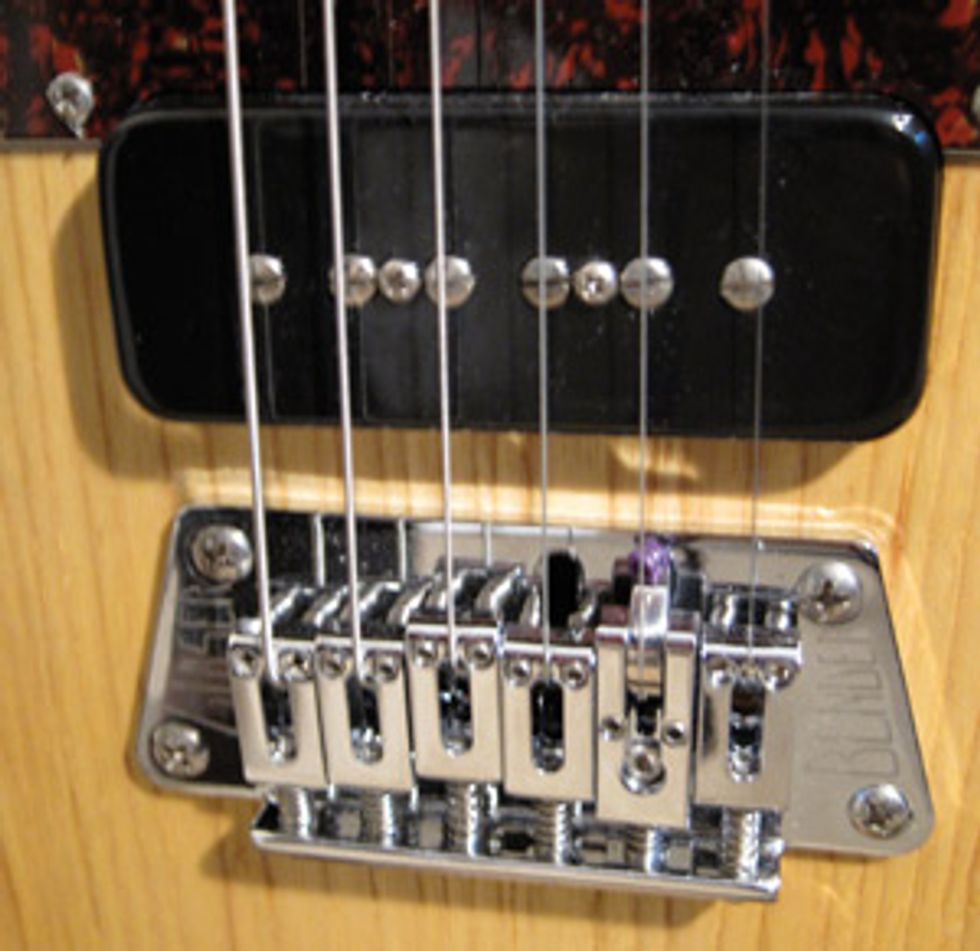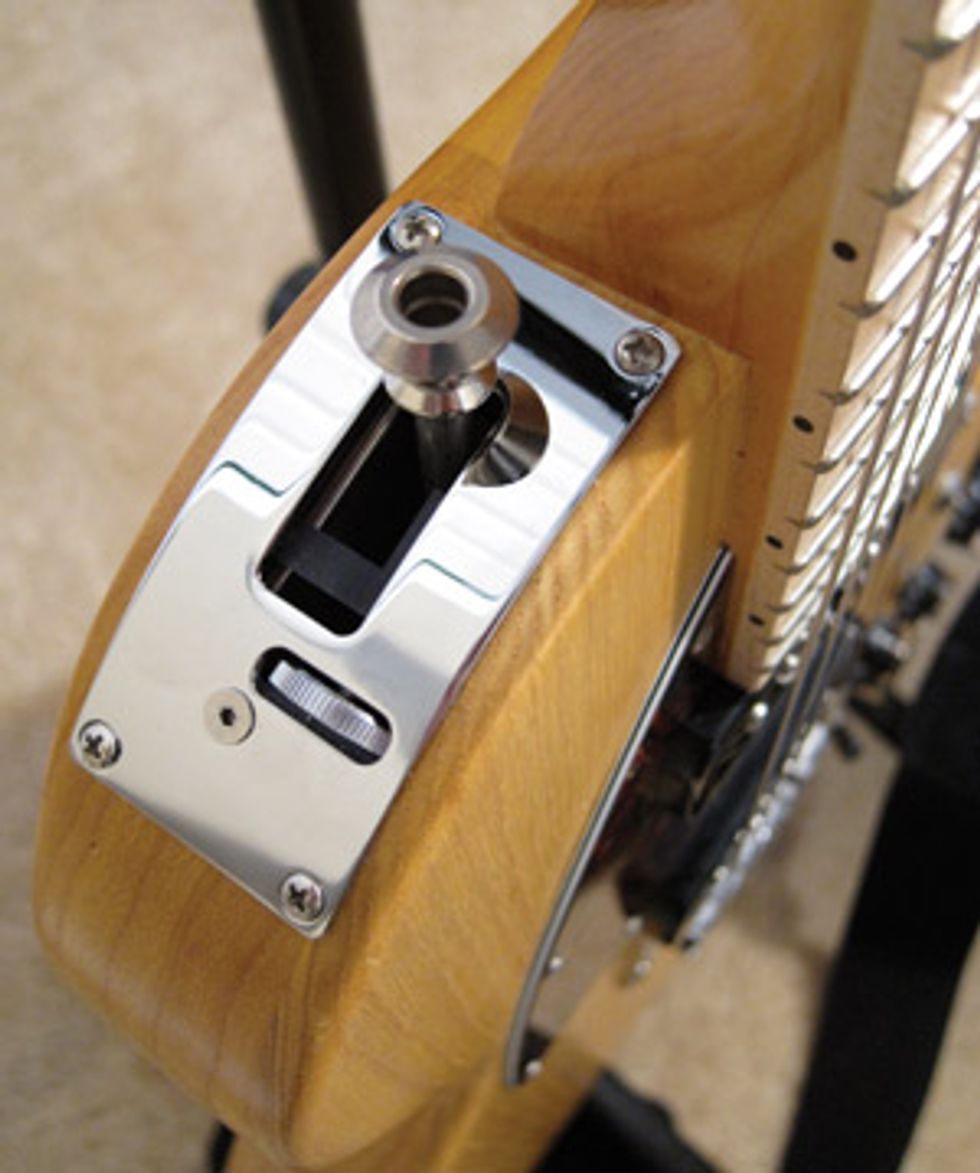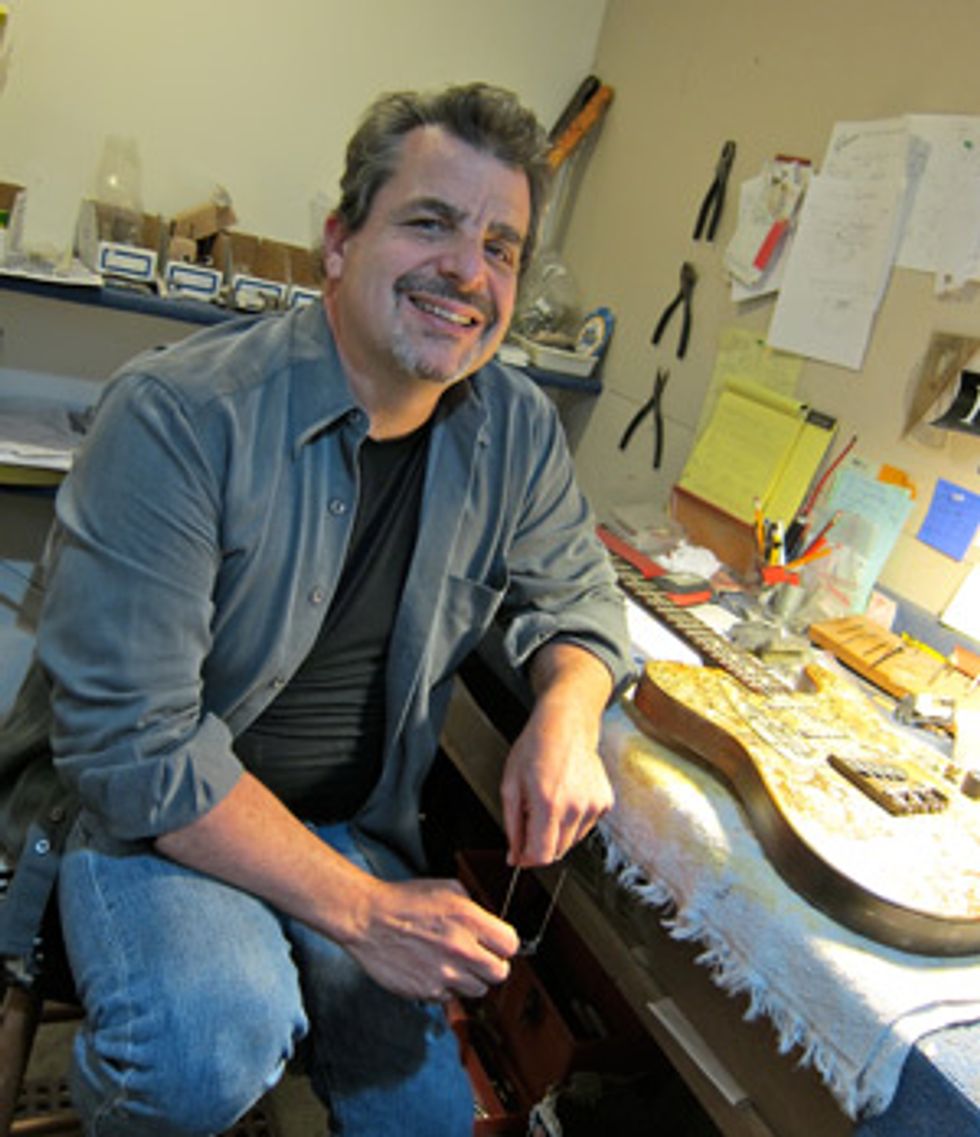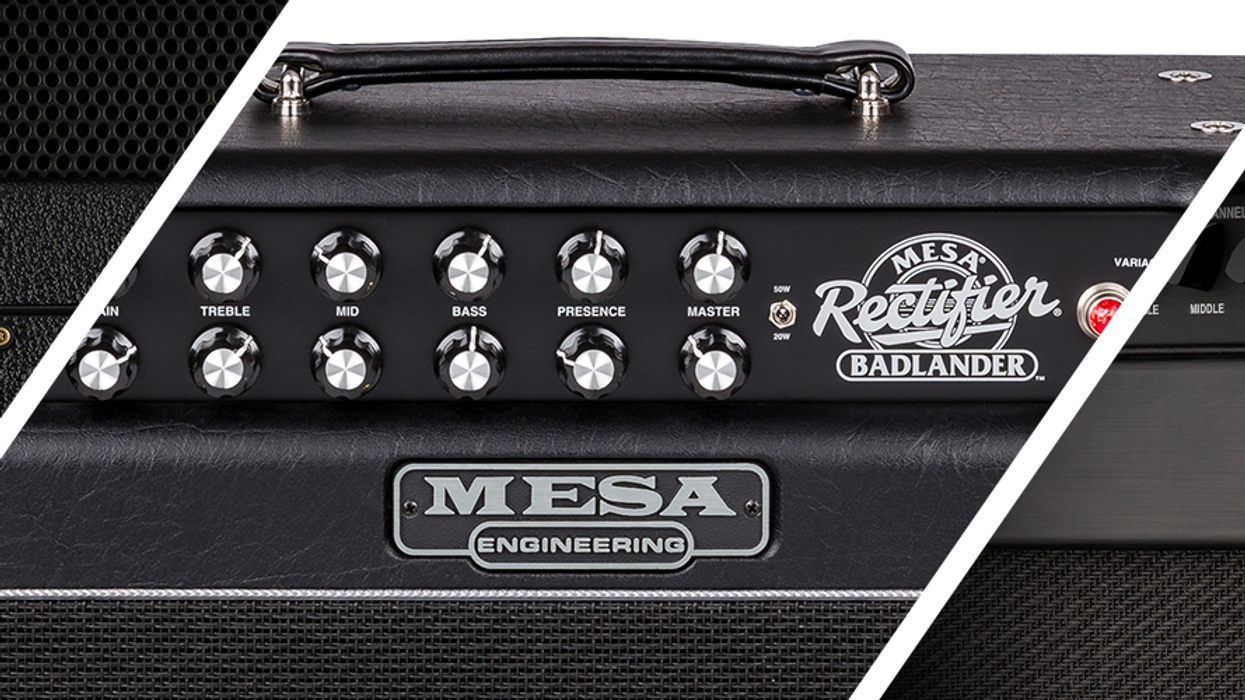Back in the early to mid '60s, bluegrass great (and eventual Byrds guitarist) Clarence White was suffering from a serious bout of pedal-steel envy. The primary symptom of the malady was an uncontrollable coveting of steel players’ ability to simultaneously bend multiple strings up, down—or both.
White was not the first to suffer from this illness, but he was one of the first to do something about it. He started by bending strings behind the nut in an effort to emulate the licks of Flying Burrito Brother “Sneaky” Pete Kleinow and other steel players. Finally, in 1967, he entreated fellow Byrds bandmate Gene Parsons to help him develop a device that would permit him to do those bends all the way up the neck.
A part-time machinist, Parsons created a mechanism he installed in White’s Fender Telecaster. It enabled White to bend the B string up a whole-step when the picker pushed down on the upper strap button. White soon incorporated the new “B-Bender” into his style, and his playing on the Byrds’ version of “You Ain’t Goin’ Nowhere” and Joe Cocker’s version of “She Came in Through the Bathroom Window” demonstrates how the device yielded a sound reminiscent of steel guitar, but with a flavor all its own.
For many years, the venerated Parsons/ White B-Bender has been (unofficially) associated with Telecasters, thanks in no small part to both the B-Bender’s progenitors and the Tele’s propensity for country-friendly twang. But the B-Bender has also inspired many other luthiers and tinkerers to design string-bending contraptions for various solidbodies over the years. But perhaps the most surprising recent entry to the field is a joint collaboration between Gibson—yes, you read right—and Nashville tech-to-the-stars Joe Glaser.
The Other B-Bender
Around the time White was
starting to gig and record with
the B-Bender, Glaser—a budding
pedal-steel player himself—
was out in San Francisco
helping a guitarist in his band
who was also trying to emulate
steel licks.
“We had some vague notion that Clarence White had a mechanism to do this, but there was no information—no internet,” recalls Glaser. “Someone told me that White’s guitar hinged at the neck joint. I couldn’t figure out how that would work—because, of course, it wouldn’t. I tried to visit Gene Parsons in Casper, California. We went to Gene’s place and knocked on his door—he wasn’t there. I don’t know why I thought he would have told me anything.”
Undaunted, Glaser went ahead with the project using the knowledge he’d gleaned working in his college machine shop. “I basically went back to the mechanism that worked on my steel guitar and took the parts in the bridge end to apply to the guitar,” he explains. “I put a crude hinge at the other end, where the strap button was. I understood you had to push down on the neck somehow to do this. [Mine] wasn’t very good, but it worked!”
By 1980, Glaser had moved to Nashville, where he was building guitars to house his B-bender. “I began pursuing a patent for a bender that had one pull going down [raising the B], one pull going out [raising the G], and another pulling in,” says Glaser. “The third one was a paddle lever you pulled against your stomach. It dropped the low-E string down a minor third, like on a pedal steel—that is a super-cool Buddy Emmons move.”
“I had to use a locking nut to do the low string—and there were no locking nuts at that point. I just put a locking brass nut across the A and the E—I had never seen a brass nut, but I knew you needed metal. When my patent attorney asked me if I wanted to patent the locking nut, I said no, that’s not important. The irony is that the only thing about that design that would have been really valuable is the part I didn’t patent.”
After a pre-Jerry Jones flirtation with building Danelectro-style 6-string basses for clients like Harold Bradley, Emmylou Harris, and Willis Alan Ramsey, Glaser decided to specialize in Nashville-style Telecasters. “Brent Mason wanted a three-pickup Tele so he could get a Stratocaster[-like] out-of-phase sound,” says Glaser. “Once I built one for him, my thing in Nashville became building three-pickup Telecasters with string benders.”
Vive La Différence
“I didn’t see a Parsons/White
bender until I had built my
fourth bender and already had a
patent on it,” says Glaser. “That
was good: Had I seen one, I
might have ended up copying
it. Instead I made something
totally different.”
Rather than the long metal arm that traverses the whole body in the Parsons/White bender, Glaser’s version used a thin spring to connect the lever at the bridge with the movable strap button at the shoulder. “Some people think ours is better, because we don’t route as much wood out of the guitar,” Glaser explains. “But some instruments actually sound better with a lot of wood removed. Still, some don’t, and I think our bender is more sonically transparent.”
Glaser explains what he thinks are more important differences between the two systems. “Each has its own feel,” he says. “The Parsons/ White pulls from a knob behind the bridge. It pulls the string across the saddle, but is not essentially part of the bridge. It seemed more important to me to anchor the string in the bridge so that it would sound like the other strings. In my version, it wouldn’t be dragging across the saddle and lose downward pressure.”
But while certain elements of Glaser’s design were intuitive, others required plenty of trial and error. “When I made my first bender, I put a bearing in the ‘finger’—which is what they call the piece of metal that goes down into the instrument and moves back and forth on a steel guitar. I thought a bearing would result in less friction, but it sucked all the sound out of it. I learned you want something very solid. So, with my later benders and the Gibson one, we made a special effort to make sure everything is anchored—all 12 or 15 pounds of string tension go right into the saddle and bridge.
“Another difference from the Parsons/White is cosmetic: We have a lever coming off the bridge plate, and the whole mechanism is under the bridge, whereas Gene has an excavation in the back and the mechanism drops down into there. Our whole mechanism would melt down into the size of a 9-volt battery.”
The Gibson Connection
Although these days they’re not
typically thought of as go-to
country instruments as much as
Fenders, Gibson guitars have a
long, storied history with country
music. One of the earliest
country recording stars, Mother
Maybelle Carter (of the legendary
Carter Family), played a
1928 L-5 archtop. And in the
’40s—and even after Fender’s
meteoric rise in the ’50s—you
were as likely to see a country
guitarist sporting a Gibson
ES-335 as a Telecaster. Country
guitar legend Hank “Sugarfoot”
Garland teamed up with
Gibson and fellow Nashville
picker Billy Byrd to design the
Byrdland guitar (whose moniker
was a combination of both
players’ surnames). Garland also
played Gibson ES-150 and electrified
L-7 instruments. Even
the iconic Chet Atkins moved
from Gretsch to Gibson in his
later years. And today’s rock-tinged
country music certainly
sees its fair share of Gibson
action—including Keith Urban
and his Les Paul Juniors.
The genesis of Gibson’s recent partnering with Glaser was a trip that Gibson’s Frank Johns made to Guitar Center. “They had a Fender Nashville Telecaster with three pickups and a Parsons/White-style B-bender,” he says. “I picked it up and thought it was pretty cool. That got me thinking. We knew Joe Glaser, [and we thought] maybe he would want to do something with Gibson. I didn’t want to half-do it—[and] Joe had the knowledge and the technology already. We had faith in him, and so do the artists.”

Glaser picks up the story. “At first, they wanted to make a Gibson run of the [sister company Valley Arts] Brent Mason [T-style] guitars with a bender in it. But I wasn’t that interested in doing a Telecaster with Gibson.”
Then Frank Johns came up with the idea of putting a bender on a dual-P-90 Les Paul Special. “We didn’t want to copy Fender—we didn’t get where we are today by copying other people’s designs—so it morphed into this. The pickguard, ash body, and maple fingerboard with the black dots nod a little to the Tele style, but that is where we wanted to end it. We used one of our Nighthawk bridges and converted that into Joe’s B-bender. It is a combination of something that we had with new technology. The P-90 is part of our history, and many players like the extra winds of wire that give the P-90 its tone. When you look at Keith Urban, he is playing Juniors with the P-90.”
As the new project came together, Glaser took the opportunity to tinker a bit with his original concept. “If I was going to do it, I wanted to make the bender convertible from the B string to the G,” he says. “When I built a guitar for studio player Jeff King, he wanted a G bender, and then Brad Paisley wanted one. I didn’t want to make a guitar with both, but I wanted people to be able to switch from one to the other. They can’t do it mid-song, but they can do the switch themselves.”
Because a G is thicker than a B, normally if you moved the same bender mechanism over to the G, the pull would make the pitch of the thinner-gauge string go significantly sharper. To prevent that, Glaser compensated the mechanism so that the length of leverage is identical for both strings.
“You could theoretically tune the pull anywhere from a quarter-tone to three half-steps—though few people do anything but whole-step bends,” says Glaser. “I also wanted to make it top-loading so that the string is easy to change. In our previous patent, the string had to hook inside the body like a steel guitar. If it broke, the ball end would drop into the body.”
Minutiae Matter
Because Glaser previous
B-benders were custom orders
fulfilled on an individual basis,
he manufactured the parts in
small batches. But to meet
the requirements of large-scale
Gibson manufacturing, he
needed to address some basic
design issues.

The Gibson Les Paul Junior B-Bender is a departure for the company in many other ways than just its 2nd-string pitch-altering system: It features a swamp-ash body, a maple fretboard, and tappable P-90 pickups. Photo by Michael Ross
“We totally redesigned it for Gibson,” says Glaser. “If you tear down a Glaser guitar, there is a hole the size of your fingertip under the bridge plate and the neck plate, with a tension adjuster at the butt. The Gibson has a bigger opening under the pickguard to fit a larger mechanism, which makes assembly easier. Larger is also more stable. They can put one together in five minutes, which is not possible with the complicated, small, boat-in-a-bottle version of our standard bender. The Gibson is an original model, not a retrofit, so there is no pressure to make it small and non-invasive.”
Gibson had to make design adjustments, too. “Most of our Juniors are solid pieces of wood,” says Johns. “But this model has a 1/4" swamp-ash top and a swamp ash back—we route all the chambering into the back. It has to be very precise, because there are pivot points that have to be in the right spot or you are going to have problems. It was a challenge for us to make a hollowed-out Junior. Also, the neck pitch is flatter to aid the B-bender— our normal Junior pitch is 3/4" off of the body—this is half of that. We would normally have a four- or five-degree angle in the neck joint, but here it is zero. So we had to actually put in a little fingerboard ramp. We also had to move the toggle switch down to get it out of the way of the bender mechanism, and bring the pickguard out to the edge on the top to cover up the inner workings.”
Budget Bender
This author had a chance to live
with the new Gibson Les Paul
Junior B-Bender for a few days.
It reminded me of my first electric
guitar, a Gibson Les Paul
TV Special—essentially a Junior
with two P-90s. Though I have
played country for years, I have
virtually no experience with a
B-bender. Nevertheless, soon
after removing it from its cool
tooled-leather case, I was navigating
prototypical bender licks
fairly easily. Even more fun was
finding that licks in other musical
genres could benefit from
the ability to bend the B string
while holding down complex
altered and diminished chords.
As enjoyable as the B-bender antics were, I was equally impressed with the sound and playability of the instrument. Thus, I wasn’t surprised when Frank Johns showed me a prototype that session ace Kenny Greenberg had been using—only he’d added a strap button on the back of the neck—indicating that he didn’t use the B-bender at all, but was enjoying the instrument on its traditional merits.
In addition to its Glaser-designed bender, the new Les Paul Junior uses three recognizable Gibson knobs on its two volume (one for each pickup) and master tone controls. A push-pull pot on both volumes also allows you to tap the P-90s for a more traditional single-coil sound.

A top view of the shoulder-pull mechanism on Gibson’s new Les Paul Junior B-Bender. Photo by Michael Ross
One of the most amazing things about this new instrument is its price—the Junior B-Bender is expected to have an MSRP of less than $1,500. This is especially impressive given the number of instruments planned. “It’s a limited run, three or four hundred pieces,” says Johns. “The first run is two hundred. We will probably do a classic Gibson cherry red color for the second two hundred. It is kind of a custom instrument, but with all the work Joe has done to make it foolproof, we can build it in production, making 50 or 100 a week.”
New Directions
Although the mating of country
music with Gibson guitars
is a long-running affair—and
though the new sounds coming
out of Nashville are as likely to
feature Les Pauls and Marshalls
as Teles and Twins—Glaser
hopes the new Gibson featuring
his innovative hardware will
lead musicians beyond old or
new country and down even
more unique paths.
“I was interested in doing an entry-level guitar that was a hybrid—something that could be used in country music but was clearly a Gibson,” he says. “This should set people free to play different music that doesn’t sound exactly like somebody else. When I was building [T-style guitars], it was guys like Ricky Skaggs, Steve Wariner, and Jimmy Olander who put me on the map by playing stuff other people had not played. I am a believer in setting people up to do something that hasn’t been done, rather than supplying a market to do what has already been done. I hope that these guitars will end up in the hands of people who don’t know much about benders, so they won’t end up playing the same old thing.”









![Rig Rundown: Russian Circles’ Mike Sullivan [2025]](https://www.premierguitar.com/media-library/youtube.jpg?id=62303631&width=1245&height=700&quality=70&coordinates=0%2C0%2C0%2C0)

















